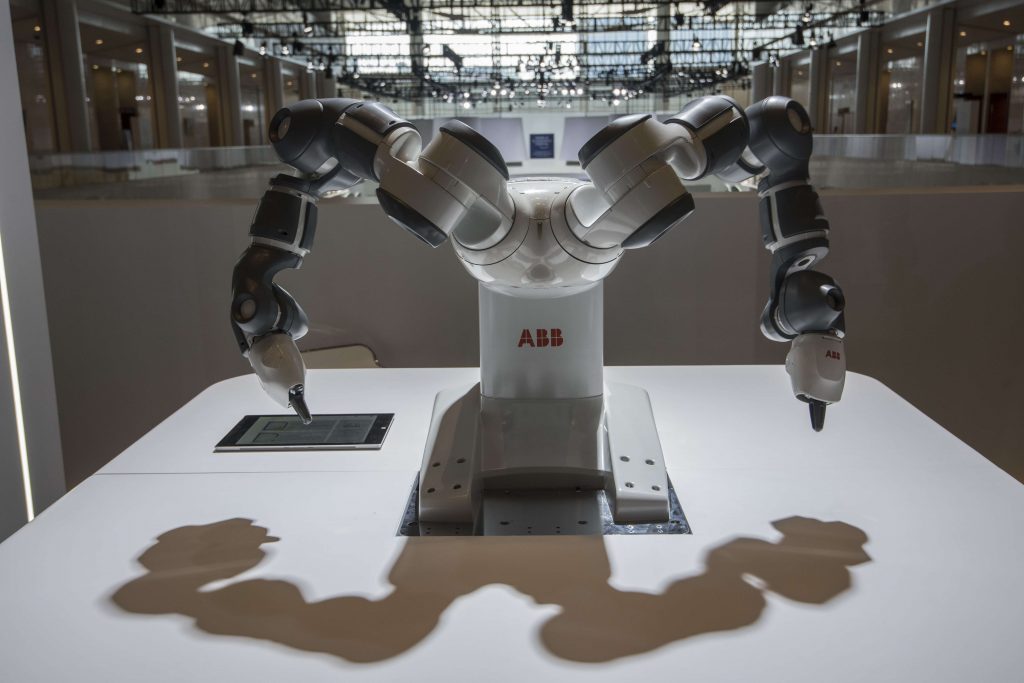How ABB’s robots perform tiny jobs, treacherous tasks – and team with humans
Chances are good that, sometime today, you will use a product built or packaged by ABB’s intelligent machines.
From the flooring beneath your feet to the building materials in your home to the device at your fingertips, ABB robots possibly played a crucial role in their creation.
The Swiss company’s industrial robots are at work in 53 countries, performing precise, high-speed tasks for hundreds of manufacturers. ABB also offers an industrial-tech platform and a cloud infrastructure with more than 210 solutions, many built on Microsoft Azure.
Last week in Munich, Germany, ABB previewed the flexible factory of the future at Automatica 2018, a leading exhibition of robotics and smart automation.
Transform recently caught up with Rami-Johan Jokela, group vice president and head of digitalization for ABB, to talk all things robots.
TRANSFORM: ABB robots manufacture, in part or entirely, most cars on the road. They finish furniture. They help make laptops and smartphones. How integral are ABB robots to our consumer lives?
RAMI-JOHAN JOKELA: ABB robots are everywhere.
For example, they package the foods we eat and beverages we drink for some of the biggest brands. Our robots also make solar panels, glassware, cookers, dishwashers and metal sinks. They’re used by pharmaceutical companies and by hospitals.
We have miniature robots doing service tasks. We have huge robots doing dangerous tasks.
TRANSFORM: What are ABB’s tiniest robots and what functions do they perform?
JOKELA: Those are our crawlers. The ABB Air Gap Inspector is used to make visual inspections inside motors and generators. This is one of the world’s smallest robots.
They can move into the air gaps as small as 10 millimeters to examine the stator core and rotor core without having to dismantle or even open the motor. This reduces repair costs and downtime for companies operating in the oil and gas, marine and power sectors, among others.
TRANSFORM: Can you tell me about some of ABB’s largest robots?
JOKELA: In the harbors, there are ship-to-shore cranes. Today’s container ships carry four times more cargo as compared to the ships 40 years ago. They are taller, longer and wider.
To handle those ships, ship-to-shore cranes have double the lifting height compared to 40 years ago. This can be a dangerous job.
But currently, more than 800 ship-to-shore cranes around the world are equipped with intelligent automation from ABB. These allow the whole cycle – from picking up containers from ships to setting them down in trucks – to be fully automatic. So each remote operator can supervise a large number of cranes, making the yard safer and more productive.
TRANSFORM: It sounds like ABB robots boost efficiencies across many industries.
JOKELA: Our connected robot platform, which runs on Azure, allows every robot to be connected to the Internet of Things to do things like condition monitoring and diagnostics, backup management and fleet assessment.
This extends capabilities of the first-line engineers and can prevent up to 25 percent of (breakdown) incidents and speed issue resolution and response time by up to 60 percent.
TRANSFORM: How is ABB changing the way humans and robots collaborate?
JOKELA: We have invented a new way for humans and robots to work in close proximity. Normally, you have a cage around the robot and if a person comes into the safety zone, the robot stops.
Our YuMi robot cooperates with human beings. The human can be close to YuMi. They can even touch elbows and the robot will keep working. YuMi runs on Azure and connects to the Internet of Things, using data-driven analytics to improve performance and reliability of the equipment and the process.
YuMi is about the size of a small person and can be installed on the production line. It can be taught a process by being physically guided through it. So, no more programming. Instead, the robot will think: This is my next task to do.
Top Image: ABB’s YuMi robot. (Photo by Thierry Falise/LightRocket via Getty Images)








